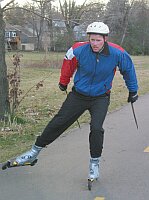High School Training and Beyond
by Kevin Brochman
December 1, 2002
A few thoughts on training high school skiers and beyond...
A skier will ski their best when they are in peak shape,
healthy and relaxed. Of course fast skis will help too. In
training young skiers for the past 20 years, I have come to
some conclusions on a few things. Many females, age 16-18
can train at a higher pulse than males of the same age. There
are some obvious reasons, on the average a 18 year old female
is 2.5 years ahead of an 18 year old male in terms of physical
development. Females also seem to be better at getting proper
sleep and staying hydrated. Staying hydrated and getting adequate
sleep seem to be the biggest factors in athlete improvement
especially during college.
I had the opportunity to observe two females during their
junior years (age 19 and younger) both went on to win more
than 10 national titles. These athletes both trained with
pulses that were higher than coaches suggested and had much
higher pulses than males at the same age. So when it comes
to training, coaches must realize that one size does not fit
all. Some athletes can train at a very high pulse as much
as 4 days per week and benefit from it. Male skiers are a
bit more fragile and must train slower, more at a talking
pace.
Some of the best ways to stay healthy are to keep your hands
washed, change your clothes after a workout and keep your
water bottle clean. If you do get sick you should not train
when you have a fever ever! It is possible to train with low
grade sickness such as colds but the athlete should keep track
of their resting pulse. If an athlete resting pulse goes up
10% then the athlete should take the day off. For example
if the athlete has 40 beats per minute resting pulse in the
morning then if it goes up to 45 they should be very careful.
Colds do hamper performance a bit and taking some of the zinc
and echinacea drops do work for some people.
A few suggestions on training, athletes should try to train
two hours on the easy days. The intervals days should have
a warm-up and warm-down phase of at least 10 minutes. The
first intervals should be done medium hard, then get progressively
harder. Technique should be the emphasis along with high heart
rates. In order for an athlete to improve they must go longer
or harder than they are used to. They must also consider how
much stress they have in their lives with sleep, work, school,
and other stressors. These stressors have a lot to do with
an athletes' ability to absorb hard training. Long slow distance
should be done at a talking pace 4-5 days per week and the
other days could be long intervals of 4-6 minutes until mid
December. After mid December, the intervals should be shortened
to 1-3 minutes for peak performance. Athletes should try to
be well hydrated when they arrive at practice. They should
try to have a water bottle to drink during and after.
Some fun ways to train hard, do intervals with two person
teams. Start the slower skiers first and the faster ones at
the end so that they all finish together. Mass start sprints
on lakes are also a lot of fun. These can be 30-60 seconds
long.
For comments or questions contact, [email protected]
 About
the author, Kevin Brochman: About
the author, Kevin Brochman:
Kevin Brochman has considerable cross-country experience,
both in racing and coaching: 1984 & 1988 Olympic Team
Member, 1998 Olympic Team Coach, 2001 World Junior Team
Coach, 1997 US Ski Team Coach of the Year.
Brochman offers various training programs during
the year through the Minneapolis Ski Club, including
a Winter Training
Program for adults.
|
Related links
|



